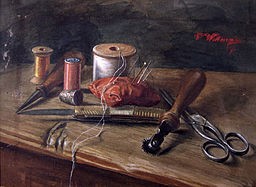The world of tailoring, steeped in tradition and precision, has become more accessible than ever thanks to online archives. Recently, Archive.org enriched its digital library with two significant tailoring books: “Tailoring Suits the Professional Way” by Clarence Poulin, and, crucially, “Classic Tailoring Techniques, A Construction Guide for Men’s Wear” by Roberto Cabrera and Patricia Flaherty Meyers from Fairchild Publications. These titles, frequently cited in tailoring bibliographies and considered essential reading, have been out of print for years, making their digital availability a treasure for aspiring and seasoned tailors alike. The ability to thoroughly examine these books online allows enthusiasts to determine if acquiring a physical copy is necessary for their collection.
The author highlights the practical value of these resources by printing instructions from Clarence Poulin’s “Tailoring Suits the Professional Way” to compare different editions. This underscores the advantage of having access to multiple versions for enhanced understanding. Poulin’s book is particularly praised for its illustration of the “drawing-in” stitch and instructions on drafting and grading, showcasing the comprehensive nature of the text.
 Vintage sewing accessories with needlework, thread spools, and scissors representing classic tailoring techniques.
Vintage sewing accessories with needlework, thread spools, and scissors representing classic tailoring techniques.
“Classic Tailoring Techniques: A Construction Guide for Men’s Wear Fairchild Publications,” is presented as a vital resource, especially when considered alongside its companion volume, “Classic Tailoring Techniques: A Construction Guide for Women’s Wear.” The author’s experience with both editions reveals key differences. The women’s wear edition lacks a vest pattern or measurements, and side vents on the jacket, but includes specific techniques like the Bound Keyhole Buttonhole and Bias Bound Buttonhole, along with features such as an unlined jacket and mandarin collar instructions.
The Men’s Wear edition of “Classic Tailoring Techniques” distinguishes itself with a more detailed approach to specific construction elements. The fly front on pants utilizes different techniques, including the French Tab and French Fly. The use of Haircloth and Flannel Cover Cloth in the canvas leads to more extensive instructions. The inclusion of vest measurements and a more thorough treatment of lining, including a breast pocket in the lining, makes this guide invaluable. Button placement for a six-button double-breasted jacket, along with detailed pants and vest construction, further emphasizes the men’s wear edition’s comprehensiveness.
The author’s perspective as an aspiring tailoress emphasizes the importance of understanding all aspects of tailoring. Having access to these digitized resources enhances the sewing experience and broadens the understanding of tailoring history and techniques. The article concludes with links to both books, promoting accessibility to these crucial tailoring resources.
- Tailoring Suits the Professional Way, Clarence Poulin, 3rd edition, 1973: Click to access Tailoring_Suits_the_Professional_Way_by_Poulin.pdf
- Classic Tailoring Techniques: A Construction Guide for Men’s Wear, Roberto Cabrera/ Patricia Flaherty Meyers: https://ia902502.us.archive.org/23/items/pdfy-LeJSGymvA1pvu1KI/Classic_Tailoring_Techniques_by_Cabrera.pdf
In conclusion, the availability of “Classic Tailoring Techniques, A Construction Guide for Men’s Wear” by Fairchild Publications in digital format represents a significant contribution to the tailoring community, offering invaluable insights into the craft of men’s wear construction.
